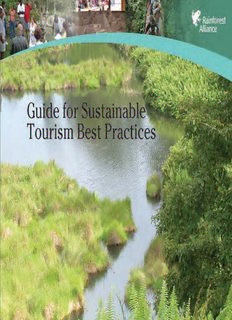
Guide for Sustainable Tourism Best Practices - Rainforest Alliance PDF
Preview Guide for Sustainable Tourism Best Practices - Rainforest Alliance
Guide for Sustainable Tourism Best Practices CONTACT US: Rainforest Alliance 665 Broadway, Suite 500 New York, NY 10012 USA Tel.: +1 (212) 677-1900 Fax: +1 (212) 677-2187 E-mail: [email protected] Website: www.rainforest-alliance.org In Costa Rica: Apdo. 11029-1000, San José Tel-Fax: +506/234-8916 www.rainforest-alliance.org G u i d e f o r S u s t a i n a b l e To u r i s m B e s t P r a c t i c e s Credits Prepared by: Sustainable Tourism Division Rainforest Alliance Technical Compiling: Alejandrina Acuña Technical Review: Ronald Sanabría Milagro Espinoza Official Translator: Luis Delgadillo Philologist: Sonya Kozicki-Jones Art and Layout: Diseño Editorial S.A. www.kikeytetey.com Financed by: Inter-American Development Bank Ford Foundation 2 Content Presentation .............................................................01 Subject 3 – Economic ............................................................81 Introduction .............................................................01 3.1 Policies and Planning ...................................................................................................82 3.2 Administration and Planning .......................................................................................90 Subject 1 – Environmental .....................................................02 3.3 Laws and Regulations ..................................................................................................92 3.4 Quality .............................................................................................................................94 1.1. Water ..............................................................................................................................03 3.5 Communication and Marketing ................................................................................101 1.2. Energy .............................................................................................................................09 3.6 Staff Training ...............................................................................................................107 1.3. Flora and Fauna .............................................................................................................27 3.7 Design and Construction ...........................................................................................110 1.4 Natural Areas and Conservation ................................................................................35 3.8 Health and Safety .......................................................................................................119 1.5 Landscaped Areas and Gardens ................................................................................40 3.9 Supplies and Suppliers ..............................................................................................122 1.6 Solid Waste ....................................................................................................................45 3.10 Monitoring and Corrective Actions .........................................................................126 1.7 Pollution ..........................................................................................................................50 1.8 Environmental Education .............................................................................................55 Glossary ..................................................................135 Subject 2 – Sociocultural ......................................................68 2.1 Cultural Activities ..........................................................................................................69 Recommended Bibliography ................................140 2.2 Contribution to Local Development ...........................................................................72 2.3 Preservation and Protection of Historical-Cultural Heritage .................................75 Literature Cited .......................................................175 2.4 Respect for Local Cultures and Communities ..........................................................79 3 Preface Introduction This second edition of the Guide includes an overview of the The Guide for Sustainable Tourism Best Practices is meant to various criteria currently used by different tourism sustainability be a facilitating tool for community businesses and for small certification programs operating in the Americas, thus covering and medium entrepreneurs to adopt specific actions that allow new issues and aspects that have emerged since the edition them take the needed steps to carry out and manage sustainable published in September 2003. development. The information has been reorganized around three main Sustainable tourism has been defined by the World Tourism subjects: the environment, and both sociocultural and economic Organization as “satisfying current tourist and host community issues. Each chapter’s theoretical and technical information has needs, while protecting and improving future opportunities. It been expanded. is seen as a guide in managing all resources, in such a way that economic, social, and aesthetic needs may be met, while The Guide has been produced with support from InterAmerican maintaining cultural integrity, essential ecological processes, Development Bank Multilateral Investment Fund. biological diversity, and life support systems.”1 Making a reality of sustainable tourism entails adopting “best practices,” namely, corrective or improved measures implemented in every area of tourist business management and operation. These actions are aimed at ensuring that the least possible impact is caused, that tourist product quality and image are improved, that business development becomes more efficient, and therefore, social and economic development does as well. 5 1. Environmental 1.1 Water 1.2 Energy 1.3 Flora and Fauna 1.4 Natural Areas and Conservation 1.5 Landscaped Areas and Gardens 1.7 Pollution 1.8 Environmental Education 1. Environmental Water Environmental 1.1 Water unable to live in a marine environment. On our planet, the sea is the water resource holding the most varied life forms, from such simple unicellular organisms as protozoa, to giant whales.4 1.1.1 CONCEPTS Tapping water resources for different activities, such as energy Water “is the most abundant component on the surface of earth generation, agriculture, human consumption, and industry, and, in a more or less pure form, makes up rain, fountains, among others, puts pressure on water availability and quality. rivers, and seas; it is a constituent part of all living organisms, Throughout this century, global water demand has increased and appears in natural compounds.”2 For instance, note the seven-fold, whereas global population has tripled. Currently, percentages of water content for the following items: the future of water reserves depends on the use we make of this fragile and limited resource. Water shortages could lead to w A growing tree = 50% water. conflicts among users, but may also foster cooperation, as shown today by water partition treaties and multiple agreements.5 w A woody tree = 75% water w An aquatic plant = 95% water 1.1.2 IMPORTANCE w Tomatoes = 95% water All living creatures need fresh water; without it, earth would be a lifeless planet. Water is found in rivers, lakes, lagoons, ground sources, and the atmosphere; however, compared to our world w Apples = 85% water size, and considering how essential it is to life, we actually have very little fresh water available: less than 1% of our planet’s total w Melons = 98% water water is liquid fresh water. w Potatoes = 80% water3 Although we can live with as little as 5 liters of water a day or less, we usually need much more than that to stay healthy. It has Water is the most abundant substance on earth and the ideal been estimated that a person needs 50 liters or more every day medium for life. Every ocean, river, and lake has its own specially to meet personal and household needs. In developed countries adapted flora and fauna. That is why most marine organisms they use much more than this: a daily average of 400-500 liters cannot live in fresh water, just as fresh water beings would be of water per person6. 9
Description: